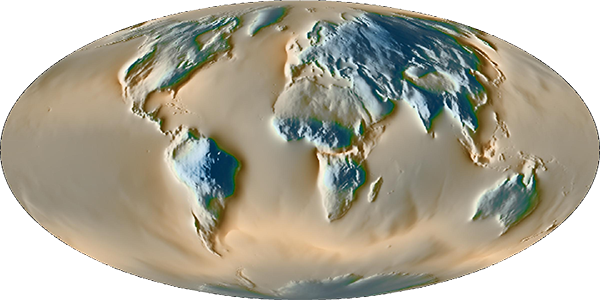Displacements for all sites
We provide 3-D (North, East & Up) displacements in millimeters
for 10962 sites worldwide (Figure 1) due to atmospheric, oceanic and hydrological
surface loading processes
in the Center-of-Mass (CM)
& Center-of-Figure (CF) reference frames.
1. Operationnal products
- ATMIB: atmospheric loading estimated from surface pressure from ECMWF
operational model (3 hours), assuming an inverted barometer ocean
response to pressure forcing.
- ERA5_IB: atmospheric loading estimated from surface pressure from latest
ECMWF Reanalysis (ERA5) (1 hour), assuming an inverted barometer ocean
response to pressure forcing,
- ERA5_TUGO: atmospheric loading estimated from surface pressure from latest
ECMWF Reanalysis (ERA5) (1 hour), assuming a dynamic ocean response to
pressure & winds from TUGO-m barotropic model (update of Carrere &
Lyard, 2003),
- ERA5_hydro: hydrology loading (soil moisture and snow), from ERA5 Reanalysis
(0.25 degree, 1 hour).
- ERA5_land: hydrology loading (soil moisture and snow) from ERA5 land
(replay of the land component of the ERA5 climate reanalysis), (0.10 degree,
1 hour).
- MERRA2_atm: atmospheric loading estimated from surface pressure from MERRA2
(Gelaro et al., 2017) (1 hour) model, assuming an inverted barometer ocean
response to pressure forcing,
- MERRA2_hyd: hydrology loading (soil moisture and snow), estimated from MERRA2
(Gelaro et al., 2017) (1 hour, 0.50x0.625 degree) model.
Permanently ice-covered regions have been masked out.
- GLDAS2: hydrology loading (soil moisture, snow and canopy water),
estimated from GLDAS/Noah v2.1 (Rodell et al., 2004) (3 hours, 0.25 degree) model.
Permanently ice-covered regions (Greenland, Alaska, mountain
glaciers, etc.) have been masked out.
- GLDAS2.2: hydrology loading (soil moisture, snow and canopy water),
estimated from GLDAS/CLM v2.2 (Rodell et al., 2004) (daily, 0.25 degree) model,
assimilated GRACE and GRACE-FO data.
Permanently ice-covered regions (Greenland, Alaska, mountain
glaciers, etc.) have been masked out.
- GRACE: hydrology and non-tidal oceanic loading, estimated from NASA GSFC iterated
global mascons (RL06v2.0, 1-arc-degree equal area cells)
(Luthcke et al., 2013; Loomis & Luthcke, 2016; Loomis et al., 2019).
GIA effects are removed using ICE6G_D model (Peltier et al., 2018).
- ECCO2: non-tidal ocean loading estimated from ECCO2 (Menemenlis et al., 2008) ocean bottom
pressure (daily, 0.25 degree).
New products: daily average of the time series are now
available for the 1-hour & 3-hour products (e.g.
ATMIB, all ERA5 & MERRA2 and GLDAS2).
Careful: As TUGO-m model is forced not only by atmospheric pressure but also by surface
winds, loading estimates from classical ocean general circulation model (such as ECCO2) should not be
added to the (ECMWF+TUGO-m) loading computations.
2. Old products (no more updates)
- ATMMO: atmospheric loading estimated from surface pressure from ECMWF
operational model (3 hours), assuming a dynamic ocean response to
pressure & winds from TUGO-m barotropic model (Carrere &
Lyard, 2003) (3 hour & 0.25 degree).
- ERAin: atmospheric loading estimated from surface pressure from ERA interim
(ECMWF Reanalysis) model (6 hours), assuming an inverted barometer ocean
response to pressure forcing,
- ERAhyd: hydrology loading (soil-moisture and snow) estimated from ERA interim.
- ECCO: non-tidal ocean loading estimated from ECCO1 (kf080i) (Wunch et al., 2009) ocean bottom
pressure (12 hours, about 1 degree),
- GLORYS: non-tidal ocean loading estimated from GLORYS2v3 (Ferry et al., 2012) ocean bottom
pressure (daily, 0.25 degree).
We use different land/sea mask models depending on the loading computations; for ECMWF products (operational or reanalysis), we use one with a 0.10-degree resolution, for the others
(ECCO, GLORYS, GLDAS & MERRA), we use a 0.25-degree mask. Both of them are derived from the GMT
(Generic Mapping Tools) database.
Figure 1: Location of the sites; the names & coordinates can be
found here
Please drag the map to see eastern, western, northern and southern sites

